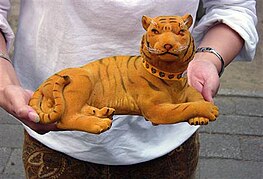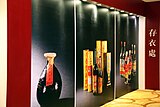Tiger bone wine
 Bone strengthening wine for sale inQinhuangdao,China | |
| Country of origin | China |
|---|---|
| Alcohol by volume | 58% |
| Ingredients | Rice wineor white wine, tiger bones,ginger,sage |
| This article is part ofa serieson |
| Alternative medicine |
|---|
 |
Tiger bone wine(Chinese:Rượu hổ cốt;pinyin:Hǔ gǔ jiǔ) is analcoholic beverageoriginally produced inChinausing the bones oftigersas a necessary ingredient. The production process takes approximately eight years and results in a high alcohol concentration. According totraditional Chinese medicine,the specific use of certain body parts is capable of healing diseases according to the characteristics of the animal used to obtain the product, that is believed to be connected with the disease of the person.[1]
History
[edit]In the Chinese culture, it was a tradition to use wines as a cure for diseases; this practice dates back to the Han dynasty's period of domination.[2]The first reference to the specific involvement of tigers in the creation of the wine is around 500 AD.[3]The demand for products containing animal body parts accelerated in the 1980s, during the process of industrialisation and the concomitant population increase: in this way, the booming of the middle class has led to more affordability to the purchase of these. The decreasing availability of tiger parts resulted in substantially higher prices, with bottles sold for hundreds of dollars each. In the 1990s, biologists and other researchers identified that the number of tigers used to make tiger bonewine(which were mainly fromSouth China) had severely decreased. Traditional medicine's excessive demand for exotic-animal body parts is claimed to be a major factor in the tiger's current state offunctional extinction.[4]

Tiger wine production and commercialisation continued, although the ingredient of the animal has been omitted from the labels since then: the production of the tonic wine went on despite the ban on trading the animal components due to the existence of tiger farms together with legal shortcomings and few government regulations.[5] In 1986, the first tiger farm was created in South China. This type of facility was classified as a zoo, until it was discovered that its actual function was to breed tigers like livestock. These facilities are managed so that tigers reproduce quickly, and newborns are removed from their mothers soon after birth so that the females can more quickly produce another cub. Tiger farms are located in China,Southeast Asia,andSouth Africa.[6]In February 2018, these facilities were estimated to host more than 8,000 tigers, double the number in the wild. An investigation in Thailand led to the discovery of a disguised tiger farm with an income of about 3 million dollars a year. In a raid in 2016,Thai authoritiesseized the 137 tigers in a temple that lead to the discovery of tiger parts and 40 dead tiger cubs which were about to be used for wines and medical purposes.[7]The consumption of tiger bone wine is believed to be limited mostly to the elder part of the population, since traditional medicine is being replaced by more modern,evidence-based medicineamong younger people.
Geography
[edit]The concept of tiger bone wine originated in China, but its use has spread throughout Asia and worldwide. Although the tigers used to make wine were traded from various places, most countries' import and export operations have been disguised. Since 1992 China has continued to export tigers’ bones toSouth Korea,as well as toIndiaandMalaysia.[8] Also European countries, such asCzech Republic,are believed to have contributed to the commerce of various parts of the animal in interest to Asia. The tigers used to make Tiger Bone Wine are taken from the farms. The farms are mostly allocated in China,Thailand,LaosandVietnam.[9] Even if the trade of tigers to make health tonics is said to be furnished by indigenous tigers, many safari and wildlife parks used to promote that the tiger bone wine was produced by captive tigers. Examples of this are the Badaling Safari Park in Beijing (October 2005) and a park inShanghai,which also sold the wine. In 2007 the tiger breeding center in Heilong gian g was defined as another place where the wine was commercialised. In 2004, it was established a new factory, the Xiongsen Wine Producing Ltd. Co, in theGuilin-based Xiongsen Bear and Tiger Mountain Village, where the wine was produced and sold.[2]
Typical ingredients
[edit]The main component of tiger bone wine is tiger bones, which are crushed and then left to macerate for several years in a liqueur made from rice. For each 1 kilogram (2.2 lb) of bones about 15 litres (3.3 imp gal) of wine are obtained. Their price increases according to the period of ageing.[10]

The active ingredient per unit volume is fixed and, therefore, it may be used to control the therapeutic dose. In addition to the bones of the animal, other ingredients are:
Two kinds of tiger bone wine are sold: the true one, made with the bones of tigers and other felines; and the common tiger bone wine, containing bones obtained from various other species, such as dogs, pigs, bears and horses. The cost of "common" tiger bone wine is significantly cheaper than a "true" one.[11]
Variants
[edit]The original ingredients are often commonly substituted with herbs, similarly as in the case of the linimentDit Da Jow:even in those cases, the beverage is still referred to as "tiger bone wine." There are more than 200 variants, produced withangelica,licorice, scutellaria, and/orLigusticum striatum( xuyên khungchuānxiōng), which generally generate the same effects and reactions in those who use them. Goat blood, Python meat,psoralen,cockroaches,bezoars,moss,rhinoceros horns,andCordyceps sinensisare sometimes included in the beverage.[12]
Production
[edit]The production has not changed over the past centuries, using the following steps:
- After the skin and muscles are peeled off, bones and even entire skeletons arrive at thedistillerywhere they are soaked several times inalcohol.
- The bones are then removed and the remaining liquid is put intophials.
- The phials are stored in batches to mature for a minimum of three years, before they are ready to be distributed.[13]
Tiger bone wine is easier to preserve in its bottle form and, being alcoholic, it may be stored for a long time without spoiling.[citation needed]
Medical purposes
[edit]In China, in accordance with the field of medical research, tiger bone cannot legally be used for testing after government authorization.[14]
It can be used as a beauty emollient.
The calcium and protein found in tiger bones are said to have healing properties, and they are often used as ananti-inflammatorydrug to treat:
- rheumatism;
- arthritis;
- general weakness;
- headaches;
- stiffnessorparalysisin lower back and legs;
- dysentery.[4][15]
Apart from stimulating blood flow, the popular belief is that it is also considered to have properties that boostintelligence quotientand that increasevirilityin men.[16]The "Compendium of Materia Medica" is a catalogue that was written over four hundreds years ago by the Chinese physician-scientistLi Shizhen.It credits tiger bones with driving off evil spirits, ghosts, and poisons; stopping convulsions; and treating acne.[17]
Controversy and conservation issues
[edit]
Examinations conducted by differentNGOs,such as theEnvironmental Investigation Agency,have reported that several 'farms' are closely linked to the production and distribution of the liquor on theblack markets.[18]
Around 1,800 tigers are kept in the tiger farms of Xiongsen Bear and Tiger Mountain Village, inGuilin,in southwest China, in order to be used to produce as many as 200,000 bottles every year.[19]
In 2008, the U.K.-based Sunday Telegraph reported that undercover investigators had been offered the chance to buy wine made from the crushed bones of tigers at theQinhuangdao Wildlife Parkrescue centre in north China'sHebeiProvince, as well as at the Badaling safari park in Beijing.[20]
Starting from January 2017, as suggested by the formerMinister of Water and Environmental Affairsof South AfricaEdna Molewa,a dispatch of approximately 800 skeleton of lions coming fromcaptive breedingwill be sent in Asia in order to be used as a substitute of the traditional local tiger ingredients used.[21] The trade in endangered species has been subject to international ban since 1987, and has been prohibited by the government since 1993, when China joined theConvention on Biological Diversity,previously opened for signature for the Earth Summit in 1992. From 29 October 2018, the commerce of both rhino horns and tiger bones has been legalised for scientific research and traditional medicine.[22]According to the announcement, tiger parts have to be taken from farmed species, and can be used only in 'recognised structures by qualified doctors recognised by theState Administration of Traditional Chinese Medicine'. This unpredictable decision has yet to be explained to the public, but experts believe that it can be considered as an economic move, due to the high value that the commerce of traditional Chinese medicine has on Asian markets.[23][24]
Gallery
[edit]In December 2011, an auction house based in Beijing auctioned about 400 bottles, in the guise of health tonics and liquors. The auction was interrupted due to the intervention ofIFAW.Eventually, the Chinese government agreed to stop the sale of hundreds of bottles that were exposed at the auction.[25]
See also
[edit]- Alcoholic drinks in China
- Bokeo Province
- CITES
- Edna Molewa
- Shenyang zoo scandal
- Tiger hunting
- Traffic (conservation programme)
- Wildlife smuggling
References
[edit]- ^Guynup, Sharon (29 April 2014)."Tigers in Traditional Chinese Medicine: A Universal Apothecary".National Geographic.Archived fromthe originalon 11 February 2018.
- ^abKristin Nowell; Xu Ling (2 March 2007)."Taming the tiger trade"(PDF).Traffic.
- ^Ian Michler (22 February 2009)."Tiger-Bone Wine".Blood Lions.
- ^abLauren Rothman (4 January 2015)."China Can't Get Enough of Black Market Tiger Bone Wine".Munchies.Vice Media.Retrieved8 November2018.
- ^Stoner, Sarah; Krishnasamy, Kanitha (September 2016)."REDUCED TO SKIN AND BONES"(PDF).Traffic Briefing.
- ^"Tiger Farming".Environmental Investigation Agency.
- ^Vidal, John (4 June 2016)."Tiger temple scandal exposes the shadowy billion-dollar Asian trade".The Guardian.
- ^Judy Mills; Peter Jackson (August 1994)."Killed for a Cure: a review of the worldwide trade in Tiger Bone"(PDF).TRAFFIC International.
- ^Unknown."WWF position and recommendations on tiger farming"(PDF).WWF Global.World Wide Fund For Nature.
- ^Sottile, Loredana (28 February 2013)."Il vino di tigre: dalle ossa dei felini in estinzione un vino medicinale. In Cina è un pregiato elisir".Gambero Rosso (in italian).
- ^O'Flanagan, Deby (29 July 2014)."What is tiger bone wine?".The tiger club blog.
- ^"Sắp biến mất ở lịch sử sông dài trung một khoản rượu thuốc —— rượu hổ cốt giám định và thưởng thức".PTT News(in Chinese). 22 August 2018.Retrieved6 December2018.
- ^Rachel Tepper (28 February 2013)."Tiger Bone Wine Trade Reveals China's Two-Faced Approach To Conservancy".Huffington Post.
- ^Kasnoff, Craig."Traditional Chinese medicine and tigers".Tigers in crisis.
- ^Fine Maron, Dina (29 October 2018)."China legalizes rhino horn and tiger bone for medical purposes".National Geographic.Archived fromthe originalon 29 October 2018.
- ^Brendon Hong (22 July 2014)."China Is Brewing Wine From Tiger Bones".
- ^Khoa giai, trương (25 August 2006)."Quốc gia lệnh cấm ngăn không được rượu hổ cốt nhiệt tiêu một năm thu vào mấy ngàn vạn".People's Daily(in Chinese).
- ^EIA (19 April 2018)."Chinese court issues a five-year jail term for selling tiger bone wine".Environmental Investigation Agency.
- ^Knowles, George (21 April 2016)."Why 1,800 tigers are in a rundown China park: to be made into wine".Post Magazine.Incisive Media.Retrieved11 November2018.
- ^Harrison, David (7 June 2008)."Tiger sanctuaries selling bone for Chinese medicine against international law".The Telegraph.Telegraph Media Group Limited.Retrieved8 November2018.
- ^"Born Free Lion Breeding Report, 2018"(PDF).Born Free Foundation.20 March 2018.Retrieved9 November2018.
- ^Unknown (30 October 2018)."Rhino horn:Alarm as China eases 25-year ban on rhino and tiger parts".BBC News.British Broadcasting Corporation.Retrieved4 November2018.
- ^Hernández, Javier C. (29 October 2018)."China Reverses Ban on Rhino and Tiger Parts in Medicine, Worrying Activists".The New York Times.
- ^Unknown (12 November 2018)."In a blow to wildlife, China lifts a ban on the use of tiger and rhino parts".WWF.
- ^Ge Gabriel, Grace (2 December 2011)."Illegal tiger bone wine auction in Beijing must be stopped".International Fund for Animal Welfare.Retrieved6 December2018.



